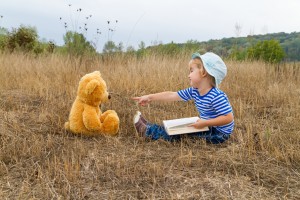Imaginary Friends
 Imaginary friends, or companions developed from one’s imagination, are most often created by young children, though adolescents and adults may also report their existence. Having an imaginary friend is considered to be an aspect of normal psychological development.
Imaginary friends, or companions developed from one’s imagination, are most often created by young children, though adolescents and adults may also report their existence. Having an imaginary friend is considered to be an aspect of normal psychological development.
Are Imaginary Friends Normal?
A study conducted in 2004 by psychologists at the University of Washington and the University of Oregon revealed more than 65% of young children had one or more imaginary friends between the ages of 3 and 7. Though preschool girls were more likely to have imaginary friends than preschool boys, the ratio was relatively equal by the time the children reached 7 years of age. According to the study, 57% of imaginary friends were humans and 41% were animals. Most children were well aware their imaginary friends were not real companions.
The relationship between children and imaginary friends is a flexible one. A child may have one or multiple imaginary friends simultaneously for a period of years or a series of different imaginary friends throughout childhood. The children surveyed in the study reported having between 1 and 13 imaginary companions. Typically, a child’s relationship with an imaginary companion is hierarchical (with the child in charge) or egalitarian. Studies have also revealed that not all imaginary companions are friendly. A number of children reported their companions were bothersome or otherwise difficult to control.
An overwhelming majority of mental health professionals believe it is perfectly normal for young children to cultivate relationships with imaginary companions and/or personified objects, such as toys that are given human traits and characteristics. Children may lose interest in one imaginary friend when they create a new one, and they commonly discard imaginary friends for good as they age and develop bonds with real playmates.
Imaginary Friends as Part of Child Development
Though the exact mechanisms are currently unknown, many psychologists believe that imaginary friends play a crucial role in the social, emotional, and cognitive development of young children. With imaginary companions, children are able to imitate the various forms of interpersonal communication observed between adults; they may also learn to develop conflict resolution skills or freely express their innermost thoughts and concerns without fear of an adverse reaction.
Some researchers have noted gender differences in the development of imaginary friends: Young boys studied were more likely to have a powerful or adventuresome imaginary companion, while young girls appeared to prefer to nurture and care for their friends. Young girls were also more likely overall to have an imaginary friend. However, boys and girls alike were shown to be better able to show empathy–though researchers are unsure whether an instinct toward empathy leads to the development of imaginary friends or if having an imaginary friend is partially what leads a child to cultivate empathic instincts.
Having imaginary friends may also help children develop an early appreciation for abstract thoughts, symbols, or situations. Almost all the children in the 2004 study claimed they had previously pretended to be an imaginary character themselves. The researchers found that 4-year-olds who practiced this form of impersonation scored higher on emotion understanding by age 7 than children who did not engage in impersonation.
Imaginary Friends and Mental Health
Though imaginary friends have been viewed in a negative light, most modern day researchers believe creating an imaginary companion can be beneficial to children in both pathological and non-pathological contexts. A major contributing factor to the negative perception of imaginary friends was the suggestion of mental health experts that these companions were most likely created to fill a void or deficit in the lives of young children.
However, imaginary friends are generally now known to be a healthy component of play, as they can provide a way for children to develop creativity while simultaneously demonstrating competence and understanding of the world in a safe environment. Imaginary friends can also help children cope with fears, anxiety, stress, trauma, and other challenging emotions or situations. Children who lose a sibling may often cope with and partially resolve their grief by continuing to speak to and play with their deceased sibling, for example.
References:
- Fritz, G. K. (2015). Imaginary friends. The Brown University Child and Adolescent Behavior Letter, 31(5), 8.
- Gleason, T. R. & Kalpidou, M. (2014). Imaginary companions and young children’s coping and competence. Social Development, 23(4), 820-839. doi: 10.1111/sode.12078
- Schwarz, J. (2004, December 9). Imaginary friends: Most kids have one (or more). University of Washington Today. Retrieved from http://www.washington.edu/news/2004/12/09/imaginary-friends-most-kids-have-one-or-more
- Shuffelton, A. B. (2012). Rousseau’s imaginary friend: Childhood, play, and suspicion of the imagination in emile. Educational Theory, 62(3), 305-321.
-
Smith, J. (2007, September 10). Imaginary Friends. Retrieved from http://greatergood.berkeley.edu/article/item/imaginary_friends
- Taylor, M., Carlson, S. M., Maring, B. L., Gerow, L., Charley, C. M. (2004). The characteristics and correlates of fantasy in school-age children: Imaginary companions, impersonation, and social understanding. Developmental Psychology, 40(6), 1173-1187.
Last Updated: 11-24-2015
Leave a Comment
By commenting you acknowledge acceptance of GoodTherapy.org's Terms and Conditions of Use.



